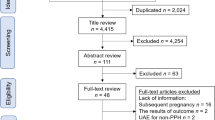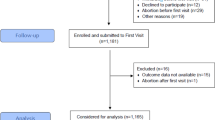Abstract
Objective:
The objective of this study is to determine whether low-dose aspirin (LDA) reduced the rate of preterm birth (PTB) in a cohort of women at high risk for preeclampsia.
Study Design:
Secondary analysis of the Maternal-Fetal Medicine Units High-Risk Aspirin trial. Preterm births were categorized by phenotype: indicated, spontaneous or due to preterm premature rupture of membranes (PPROMs).
Results:
Of 1789 randomized women, 30.5% delivered before 37 weeks (18.5% indicated, 5.8% spontaneous and 6.2% following preterm PPROMs). Among women randomized to LDA, we observed a trend favoring fewer PTBs due to spontaneous preterm labor and preterm PPROMs, odds ratio (OR: 0.826 (0.620, 1.099)); the incidence of indicated PTBs appeared unchanged, OR: 0.999 (0.787, 1.268).
Conclusion:
Although not reaching significance, we observed an effect size similar to other studies of both low- and high-risk women. These results support findings from other studies assessing LDA as a PTB prevention strategy.
This is a preview of subscription content, access via your institution
Access options
Subscribe to this journal
Receive 12 print issues and online access
$259.00 per year
only $21.58 per issue
Buy this article
- Purchase on Springer Link
- Instant access to full article PDF
Prices may be subject to local taxes which are calculated during checkout


Similar content being viewed by others
References
Moster D, Lie RT, Markestad T . Long-term medical and social consequences of preterm birth. N Engl J Med 2008; 359 (3): 262–273.
Group E, Fellman V, Hellstrom-Westas L, Norman M, Westgren M, Kallen K et al. One-year survival of extremely preterm infants after active perinatal care in Sweden. JAMA 2009; 301 (21): 2225–2233.
McCormick MC, Litt JS, Smith VC, Zupancic JA . Prematurity: an overview and public health implications. Annu Rev Public Health 2011; 32: 367–379.
Henderson JT, Whitlock EP, O'Connor E, Senger CA, Thompson JH, Rowland MG . Low-dose aspirin for prevention of morbidity and mortality from preeclampsia: a systematic evidence review for the U.S. Preventive Services Task Force. Ann Int Med 2014; 160 (10): 695–703.
Askie LM, Duley L, Henderson-Smart DJ, Stewart LA, Group PC . Antiplatelet agents for prevention of pre-eclampsia: a meta-analysis of individual patient data. Lancet 2007; 369 (9575): 1791–1798.
Coomarasamy A, Honest H, Papaioannou S, Gee H, Khan KS . Aspirin for prevention of preeclampsia in women with historical risk factors: a systematic review. Obstet Gynecol 2003; 101 (6): 1319–1332.
Silver RM, Ahrens K, Wong LF, Perkins NJ, Galai N, Lesher LL et al. Low-dose aspirin and preterm birth: a randomized controlled trial. Obstet Gynecol 2015; 125 (4): 876–884.
Caritis S, Sibai B, Hauth J, Lindheimer MD, Klebanoff M, Thom E et al. Low-dose aspirin to prevent preeclampsia in women at high risk. National Institute of Child Health and Human Development Network of Maternal-Fetal Medicine Units [see comments]. N Engl J Med 1998; 338 (11): 701–705.
Roberge S, Nicolaides KH, Demers S, Villa P, Bujold E . Prevention of perinatal death and adverse perinatal outcome using low-dose aspirin: a meta-analysis. Ultrasound Obstet Gynecol 2013; 41 (5): 491–499.
American College of Obstetricians and Gynecologists; Task Force on Hypertension in Pregnancy. Hypertension in pregnancy. Report of the American College of Obstetricians and Gynecologists' Task Force on Hypertension in Pregnancy. Obstet Gynecol 2013; 122 (5): 1122–1131.
Goldenberg RL, Culhane JF, Iams JD, Romero R . Epidemiology and causes of preterm birth. Lancet 2008; 371 (9606): 75–84.
Ananth CV, Vintzileos AM . Epidemiology of preterm birth and its clinical subtypes. J Matern Fetal Neonatal Med 2006; 19 (12): 773–782.
Laughon SK, Albert PS, Leishear K, Mendola P . The NICHD Consecutive Pregnancies Study: recurrent preterm delivery by subtype. Am J Obstet Gynecol 2014; 210 (2): 131.e131–131.e138.
Stout MJ, Busam R, Macones GA, Tuuli MG . Spontaneous and indicated preterm birth subtypes: interobserver agreement and accuracy of classification. Am J Obstet Gynecol 2014; 211 (5): 530.e531–530.e534.
Hauth JC, Goldenberg RL, Parker CR Jr., Copper RL, Cutter GR . Maternal serum thromboxane B2 reduction versus pregnancy outcome in a low-dose aspirin trial. Am J Obstet Gynecol 1995; 173 (2): 578–584.
Lewis RB, Schulman JD . Influence of acetylsalicylic acid, an inhibitor of prostaglandin synthesis, on the duration of human gestation and labour. Lancet 1973; 2 (7839): 1159–1161.
Goldenberg RL, Hauth JC, Andrews WW . Intrauterine infection and preterm delivery. N Engl J Med 2000; 342 (20): 1500–1507.
Hillier SL, Martius J, Krohn M, Kiviat N, Holmes KK, Eschenbach DA . A case-control study of chorioamnionic infection and histologic chorioamnionitis in prematurity. N Engl J Med 1988; 319 (15): 972–978.
Romero R, Dey SK, Fisher SJ . Preterm labor: one syndrome, many causes. Science 2014; 345 (6198): 760–765.
King J, Flenady V, Cole S, Thornton S . Cyclo-oxygenase (COX) inhibitors for treating preterm labour. Cochrane Database Syst Rev 2005 Apr 18;(2):CD001992.
Hammers AL, Sanchez-Ramos L, Kaunitz AM . Antenatal exposure to indomethacin increases the risk of severe intraventricular hemorrhage, necrotizing enterocolitis, and periventricular leukomalacia: a systematic review with metaanalysis. Am J Obstet Gynecol 2014; 212: 505.e1–505.e13.
Feghali M, Venkataramanan R, Caritis S . Prevention of preterm delivery with 17-hydroxyprogesterone caproate: pharmacologic considerations. Semin Perinatol 2014; 38 (8): 516–522.
Duley L, Henderson-Smart DJ, Meher S, King JF . Antiplatelet agents for preventing pre-eclampsia and its complications. Cochrane Database Syst Rev 2007 Jul 18;(2):CD000492.
Acknowledgements
We appreciate the assistance of the National Institute of Child Health and Human Development (NICHD) and the Maternal-Fetal Medicine Units Network in making the database from the Maternal-Fetal Medicine Units High-Risk Aspirin Trial available for secondary analysis. The contents of this report represent the views of the authors and do not represent the views of the Eunice Kennedy Shriver NICHD Maternal-Fetal Medicine Units Network or the National Institutes of Health.
Author information
Authors and Affiliations
Corresponding author
Ethics declarations
Competing interests
The authors declare no conflict of interest.
Rights and permissions
About this article
Cite this article
Allshouse, A., Jessel, R. & Heyborne, K. The impact of low-dose aspirin on preterm birth: secondary analysis of a randomized controlled trial. J Perinatol 36, 427–431 (2016). https://doi.org/10.1038/jp.2016.3
Received:
Revised:
Accepted:
Published:
Issue Date:
DOI: https://doi.org/10.1038/jp.2016.3



